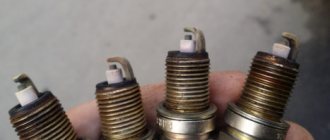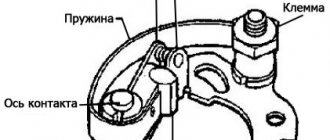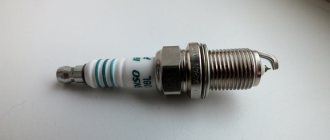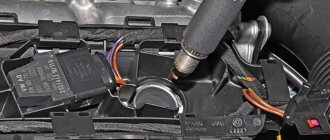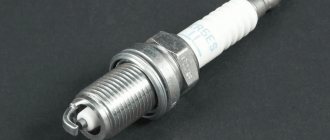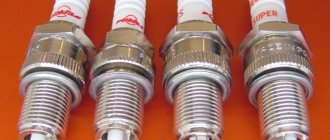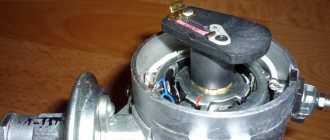How to install contactless (electronic) ignition
Installing electronic ignition is the easiest way to improve engine performance. Replacing with a contactless system provides the following advantages:
- Confident cold start;
- Stable engine operation at any speed;
- High reliability;
- Increases the service life of spark plugs;
- Powerful spark;
- No gap adjustment or centrifugal adjuster required.
The finished kit includes a distributor with a Hall sensor, a special ignition coil and a switch. It is possible to leave the old high-voltage wires.
The electronic ignition system includes: an ignition coil, a distributor, a switch and a set of wires
To install contactless ignition to replace the old one, we need a key for “13” and “10”, two screws for fastening the switch and a strobe for adjusting the advance angle.
The order of work performed:
- We bring the crankshaft pulley to the mark on the engine cover, the piston of the first cylinder should be at TDC.
- Disconnect the negative terminal of the battery.
- Remove the cover from the old distributor and note the position of the slider relative to the engine. This will help you quickly install and configure the new distributor.
- We disconnect the wire coming from the ignition coil, unscrew the lock with a key set to “13” and remove the distributor from the engine block.
- We install the new distributor according to the marks made, trying to align the marks on the body and the position of the slider. Do not tighten the fastening completely.
- We replace the ignition coil with a new one and install the switch under the hood. Place the electronic unit in a dry place, away from heated parts. For example, on the wing or engine shield.
- We connect the wiring according to the diagram in the instructions for the BSZ. We connect high-voltage wires.
- Close the distributor with the lid and tighten the fastening nut. The system is installed and ready to use. All that remains is to adjust the ignition timing.
Contactless ignition circuit for VAZ 2106
Important! BSZ systems may differ in the length of the distributor shaft for different models of classic Zhiguli engines, so before purchasing it is worth checking with the seller about the interchangeability of components.
Installing NGK spark plugs on a VAZ 2106
For stable operation of the power unit, it is customary to install Japanese NGK VAZ 2106 spark plugs on classic Zhiguli models, as well as high-quality products from other foreign parts of the A17 series, which, as a rule, are unreliable in operation and have a short service life. But to install imported spark plugs, you need to know which ones are suitable for the “six” in terms of parameters.
Reasons for replacing elements
The spark plug in any car must function in difficult conditions, solving the following problems:
- promptly ignite the air-fuel mixture compressed in the cylinder;
- provide an even and powerful spark discharge on its contacts;
- sparking should not deteriorate under any engine operating mode.
For ignorant car enthusiasts, checking spark plugs comes down to a “spark” test. This gives rise to an erroneous statement: if, when connected to a source, a spark jumps between the contacts, then the element is in good working order.
But the conditions inside the combustion chamber differ from normal atmospheric ones, since there is high pressure (over 10 Bar), and instead of air there is fuel plus high temperature. Often, a spark plug that produces a reliable spark discharge in air, in the cylinder, works with misfires or does not spark at all.
The operability of the elements can only be determined on a stand with high voltage applied and pressure created in the chamber. Such a check is not available to most ordinary motorists; the only way out is to promptly replace the VAZ 2106 spark plugs by purchasing high-quality products from well-known manufacturers. These include famous brands NGK, Bosch, Beru and Brisk.
Russian spark plugs of the A17 series cannot boast of a long service life and fail after 15-20 thousand kilometers, as evidenced by the following signs:
- The engine "troits". Moreover, sometimes it is impossible to understand which cylinder is failing, since all 4 spark plugs skip ignition cycles.
- The car performs poorly and is unstable until it warms up.
- With high fuel consumption, a drop in power is observed.
- A particularly bad case is when the oil pressure light comes on. This is the result of long-term driving on bad spark plugs, when the fuel that does not burn in the cylinders flows into the crankcase and dilutes the oil, causing its pressure to drop.
Every car enthusiast should remember that if the power unit malfunctions, the first step is to unscrew the spark plugs and visually check their condition.
The color and thickness of carbon deposits on the contacts can tell a lot to an understanding motorist:
- black carbon deposits on the contacts indicate that the fuel in the chamber does not burn completely, perhaps the spark plug has failed;
- a white coating on the electrodes indicates a poor air-fuel mixture, the spark plug is working;
- red carbon deposits indicate that the fuel contains harmful additives; the spark plug is most likely in good working order;
- thick “fluffy” carbon deposits are the result of combustion of oil entering the chamber through the seals or piston group.
The normal color of electrodes is all shades of brown with a minimum thickness of plaque.
Which parts to choose?
When choosing spark plugs for a VAZ 2106 car, you must be guided by the numerical value indicated on the marking. It denotes the heat value of the element, which characterizes the candle’s ability to remove heat and self-clean from carbon deposits during operation. According to the Russian classification, elements are divided into the following groups:
- Heat number from 11 to 16 are “hot” candles. They are designed for engines with low compression ratios and low power.
- The same, from 17 to 19. The most widely used spark plugs, including on VAZ 2101-07 cars.
- The same, from 20 to 26 - “cold” spark plugs, installed on powerful engines with a high compression ratio and temperature in the combustion chamber.
If you install too “hot” or “cold” spark plugs on a VAZ 2106 car, the engine will not be able to function in normal mode with maximum efficiency. The letter indices on the marking indicate less important parameters, but they also need to be taken into account. For example, a product with the designation A17DV is suitable for engines with a carburetor and an ignition system with mechanical contacts, and A17DVRM is suitable for power units with an injector.
The trouble is that the classification of imported candles differs from Russian ones, and there is no single measurement system; each manufacturer has its own. Therefore, before you buy reliable products from the Japanese company NGK or another brand for the VAZ 2106, it is recommended to study the table.
Using the table, you can select elements from some foreign brands for classic Zhiguli models with different fuel supply methods and types of sparking systems.
Recommendations for replacement
Before you start replacing VAZ 2106 spark plugs, you need to make sure that the gap between the electrodes in the new parts is 0.7-0.8 mm for cam ignition systems and 0.8-0.9 mm for electronic ones. The gap is measured with a flat feeler gauge; in spark plugs with several side electrodes - with a round one.
The replacement algorithm is as follows:
- Turn off the ignition and remove the high-voltage wires from the spark plugs, holding them by the tips.
- Unscrew the old parts and clean the seats with a brush.
- Screw in new spark plugs, tighten them with medium force.
- Connect the wires and start the engine.
When connecting high-voltage wires, it is important not to mix them up, so you need to follow the markings on the distributor cover.
Modern technologies
What I want to say in conclusion, many will think “come on,” why should I bother with some distance between the electrodes! Guys, very wrong thoughts.
Firstly , you can save on fuel, studies show up to 5 - 7%
Secondly , smooth engine operation is the key to driving safety.
Third , the correct gap between the spark plugs increases their service life; there is no chance that the insulator will break through (with an increased distance).
Spark plugs for VAZ 2106, 2107, 2108, 2109
VAZ 2106, 2107, 2108 and 2109 cars are very similar to each other in their design and engines. However, they were produced with both an injector and a carburetor, so when choosing spark plugs you need to focus on the fuel system and ignition option (contact or non-contact). The manufacturer of original spark plugs for all of the above cars is the Russian company “E3”, Engels.
According to the rating of spark plugs for the VAZ 2106 on PartReview dated 05/07/20, owners prefer NGK products. Manufacturers BRISK, Denso and Finwhale also stand out.
Spark plugs for VAZ 2106, 2107, 2108 and 2109 – which ones to install?
The technical characteristics of spark plugs for engines of cars 2106/2107/2108/2109 differed from the fuel supply system to the combustion chamber. On VAZ 2106 and 2107 with carburetors and a contact ignition system, spark plugs with article number 21010-3707010-86 are provided from the factory. For carburetor 2106/2107/2108/2109 but with contactless ignition, spark plugs with article numbers 2108-3707010-86 or 21080-3707010-86 were installed. But in fact it is the same spare part. They are interchangeable. But on injection cars of this series, the spark plugs were somewhat different.
With injection engines on VAZ 2107, 2108 and 2109, spark plugs with article numbers 21110-3707010-86, 21110-3707010-00 or 2111-3707010 were installed. The main difference between spark plugs on injection and carburetor engines is the gap size. Otherwise, all these are ordinary nickel single-pin spark plugs with a heat rating of 17 and a tightening torque of 22 Nm.
If we talk about the rating of spark plugs for the VAZ 2107 on PartReview, owners prefer Bosch products. Manufacturers BRISK, Denso and NGK also stand out.
The rating of spark plugs on PartReview for VAZ (Lada) 2108/2109 says the following, owners buy the following brands BRISK, Finwhale, Champion and Denso.
Read more about the sizes of original spark plugs in the table.
| Spark plug type | ||||||
| vendor code | Engine | Thread / thread length, mm | Key size | Gap, mm | Heat number* | Center electrode material |
| 21110-3707010-86, 21110-3707010-00, 2111-3707010 | Injection 1.5, 1.6, 1.7 | M14×1.25 / 19 | 21 | 1 | 17 | Nickel |
| 21010-3707010-86, 2108-3707010-86, 21080-3707010-86 | Carburetor 1.1, 1.3, 1.5, 1.6 | M14×1.25 / 19 | 16 | 0.7 | 17 | Nickel |
*According to Champion nomenclature (Russian standard)
Also, original candles can be found directly from the manufacturer, the Engels plant. The article number of spark plugs for injection engines is A17DVRM, for carburetor engines there are several options - A17DVR, A17DV-10, A17DVM.
The most well-known and frequently used substitutes from other manufacturers are presented below in the list.
| Manufacturer | vendor code | Price, rub (for 1 piece) |
| Analogues for injectors | ||
| Bosch | 0242235663 | 100 |
| Denso | W20EPR-U | 100 |
| Analogues for carburetors | ||
| NGK | BPR6ES | 140 |
| Denso | W20EPU | 80 |
Sometimes, even though these are old and super-budget cars, their owners install iridium DENSO IW20TT, price - 610 rubles / piece, or platinum Bosch 0242235540 at a price of 200 rubles / piece. Both models are equally suitable for injectors and carburetors. But nevertheless, this is a little justified waste.
When to change spark plugs on VAZ 2106, 2107, 2108 and 2109?
According to VAZ 2106/2107/2108/2109 maintenance regulations, spark plugs must be changed every 30 thousand km, that is, after one maintenance. But, in fact, their actual lifespan is half as long, and drivers usually change them at every maintenance service, every 15 thousand km.
The influence of the correct clearance on engine performance
The gap is a really important parameter. It can either be big or too small.
Small gap
If small values are set between the electrodes, then misfires will occur in the ignition system. The thing is that the spark that forms between the electrodes, which are as close to each other as possible, is not enough to ignite the fuel mixture. The spark, although strong, is not sufficient. This is why many cars will really jerk when driving and not develop enough speed. The carburetors may have flooded spark plugs, which will only cause problems – it will generally cause problems. The gap needs to be increased!
How much is a small gap? If we talk about size, it is approximately from 0.1 to 0.4 mm. We definitely check the candles after purchase, I’ll give practical recommendations below, but for now let’s talk about long distances.
Big gap
You know, many manufacturers set the normal distance between the electrodes in advance. But over time, it can increase on its own.
It's all about spark plug wear, which manifests itself with high mileage - this is natural. After all, the electrodes are made of metal, which, under the influence of temperature and constant electrical discharges, begins to slowly burn out. Both the upper one, which resembles the letter “G”, and the lower one suffer. The top one becomes thin, instead of a rectangular shape, it begins to be rounded, because the sides burn out. The bottom one just sags down.
Due to this distance, the spark that passes between the contacts weakens. And significantly! It may also not be enough to ignite the fuel.
Often, because of this, the insulator of the lower contact is pierced; the whole point is that the spark tries to find the shortest path between the electrodes.
In winter, there is a high probability that the car simply will not start.
Another important aspect is that deposits in the form of soot may more often appear on distant electrodes; the spark “suffers” from the long distance, and so does deposits! It may not pass at all. Therefore, it is important after a certain mileage, with our fuel it can be already 15,000 km, to unscrew the spark plugs if necessary, change them, or clean them.
Large distance - from 1.3 mm and above.
